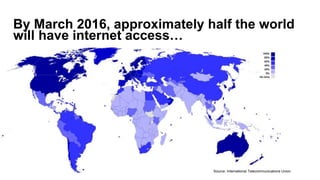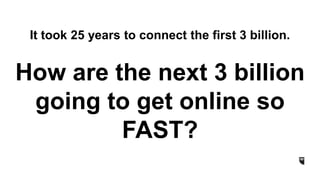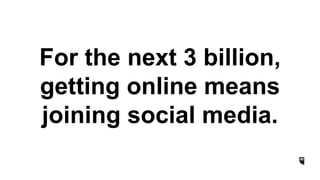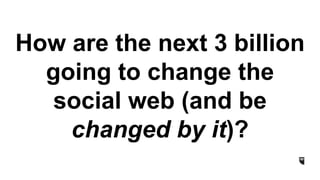The Next 3 Billion People on Social
- 1. Are you ready for the next 3 billion people to join the social web? Editorial Manager, Hootsuite @dgodsall David Godsall
- 2. By March 2016, approximately half the world will have internet access… Source: International Telecommunications Union
- 3. What about the other half? At the current rate of growth, another 3 billion people will be able to get online by the end of 2018
- 4. It took 25 years to connect the first 3 billion. How are the next 3 billion going to get online so FAST?
- 5. 3 Facts About Mobile Devices in 2015: • There are now 7 billion mobile cellular subscriptions globally. • Mobile broadband penetration is at 47%, but growing at approximately 20% annually. • 3G population coverage is at 69% of the world, up from 45% in 2011. Photo: Oxfam East Africa Source: ITU ICT Facts and Figures 2015
- 6. Internet.org If you have a web-capable device and you live in a place that already has coverage, but you can’t afford the data rates, one way you might soon get online is through the Free Basics program from Facebook’s Internet.org. Launched in 2013, the program already offers limited mobile internet service to more than 9 million people, from India to Zambia. Source: Internet.org
- 7. Project Loon For areas where expanding conventional mobile network infrastructure isn’t practical, there’s Google’s famous moonshot. Using a network of thousands of balloons circling the earth’s stratosphere, the search giant plans to provide 3G- like mobile data speeds to remote and rural areas. Source: Wikimedia Commons
- 8. Community-led initiatives Hundreds of innovative smaller projects are poised to fill in whatever coverage gaps remain. Take the Village Base Station, from a startup called Endaga: this simple, rapidly deployable technology enables remote communities to build their own mobile networks. Source: Endaga
- 9. For the next 3 billion, getting online means joining social media.
- 10. Picture the internet when most of us first got online. Now imagine connecting for the first time in 2015.
- 11. Source: comScore global, Morgan Stanley. Adapted from Morgan Stanley Internet Trends 2010 (Mary Meeker) 2006 2007 2008 2009 2010+ UniqueUsers Social is now the communication medium of choice for businesses and consumers
- 12. Websites Facebook Pages 15 Million 30 Million BusinessesintheUnitedStates Businesses are now twice as likely to have a Facebook page than a website
- 13. How are the next 3 billion going to change the social web (and be changed by it)?
- 14. That’s where these four come in… Ebele Okobi Head of Public Policy, Facebook Jonathan Donner Author, After Access Alex Kantrowitz Senior Technology Reporter, BuzzFeed News David Godsall Editorial Manager, Hootsuite @EbeleOkobi @JCDonner @DGodsall @Kantrowitz Panel Moderator














